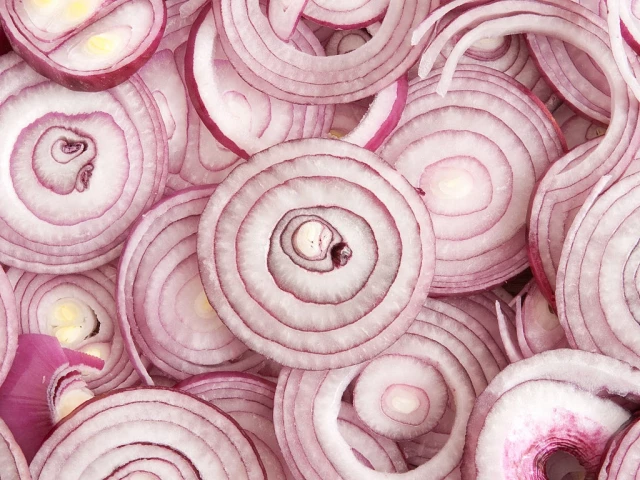During cooking, cutting onions is a real challenge because it can blur your vision and also cause lots of irritation due to its pungency. Not only this, but the compounds which make onion a pungent food are responsible to make your hands smelly, which can stay for several days. And the handling of onion becomes a difficult task due to its layers. But why do onions have layers? Is onion layers serve any purpose? Let’s have a look at onion layers.
Unlike all the other members of Allium Genus, onions grow in layers. All the layers of an onion are actually the leaves of the plant. All those leaves wrap around a bud make a cluster and when grow, the outer layer dies off and the new one sprouted.
Why Do Onions Have Layers?
Before starting the argument, let’s have a look at how onions grow when you sow the seeds. Onions start growing in the form of a small bulb. There are numerous fibrous roots under that bulb and this bulb grows into onions gradually.
However, before growing into onion this bulb wraps up into leaves. These leaves wrap around each other and make a cluster around the small bulb like a stem in the center. And these leaves make the layers of an onion when grow. The outer layer is the oldest fleshy one and becomes papery when dies off.
But at the same time, this papery layer protects the other fleshy layers which are tightly bound to each other. All these layers attach to the bulb no matter how many layers are there. Even the outermost layer also remains to attach to the bulb even it dies off and becomes papery.
Moreover, these layers would be different in numbers for both commercial and spring onions. Because spring onions are baby onions and harvested even when the bulb doesn’t get any chance to swell properly. Spring onions have a similar taste to onions but milder than commercial onions.
As, spring onion is the baby onion that’s why its bulb is of white color with a thin bulbous body. And because of it, spring onions have fewer layers than commercial onions. Because, as long as you let an onion grow its layers become thicker with increment in layer numbers.
On the other hand, commercial onions are fully grown from spring onions, with a large number of layers. And commercial onions are more pungent with a stronger taste than spring onions. However, both types of onions are equally beneficial for us in their own ways.
How Many Layers Does an Onion Have?
The layers of onion depend upon several factors like the species of onion, soil condition, harvesting time, water supply, sunlight, etc.
The number of onion layers will be different for the hybrid species and non-hybrid species. Not only this, but proper care also led to a fully grown onion with more layers. Similarly, harvesting time also affects the number of layers in an onion.
As, spring onions are baby onions because they are harvested before fully grown and thus have fewer layers than the commercial onions, which have more harvesting time.
Last but not the least, as onion leaves keep sprouting that’s why they need a space to grow bigger. But if there is less space for them or the soil is hard around them, then onions will have fewer layers.
However, commonly fully grown commercial onions have 7-13 layers. While the spring onions have less number of layers with thin onion layers.
You May Also Read: How Many Layers Does an Onion Have?
Why Do Onions Smell and Cause Irritation in Eyes?
Onions smell and cause pungency due to the Sulfur content in them. However, onions get this Sulfur content from the soil and the ratio of Sulfur content in onions affects their taste as well.
However, the Sulfur content in onions like the thiosulfinates and thiosulfonates, these Sulfur compounds are responsible for the smell into your hands. And this smell is so strong that can stay for hours until you have to remove it with some external aid like soap.
Moreover, the same compounds are responsible for irritation or pungency in the eyes. Because these sulfur compounds make sulfuric acid with air and this causes irritation in the eyes.
However, you can prevent this smell and irritation in the eyes with the following methods:
- Cool the onions in the refrigerator or cold water before cutting them. This process helps you to suppress the scattering of volatile water from the onion layers.
- To minimize the pungency of onions soak them in water before cutting them for almost 20 minutes. This will help you to dissolve the amino acids.
- Wearing goggles will also assist you while cutting the onions.
Why Are Onions Sweet?
As onions are pungent when you eat them raw but ever you think that why cooked onions are sweeter than raw onions? However, naturally raw onions have fructose (a natural sugar) whose sweeter taste is not prominent when you eat them raw.
But when you cooked the onions then the moisture evaporates causes a decrease in the pungency of onions. As fructose will not evaporate during cooking this makes sweeter taste dominant over the pungency of onions.
Moreover, the sweeter taste of onions keeps rising if you cook them longer.
A Final Thought:
Onions can spectacularly difficult during cutting due to their pungency and fleshy layers. But why do onions have layers? Onions layers are actually their leaves which are wrapping around their bud. These leaves keep sprouting from the inside of the onion bud and become thicker with time.
The outer layers become papery and start dying off while protecting the inner layers. However, the number of layers is different in commercial and spring onions.


